

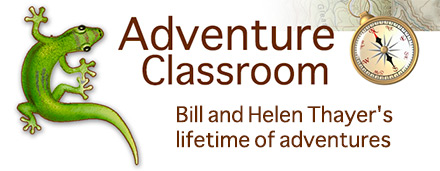
DESERT TRANSPORT - CAMELS
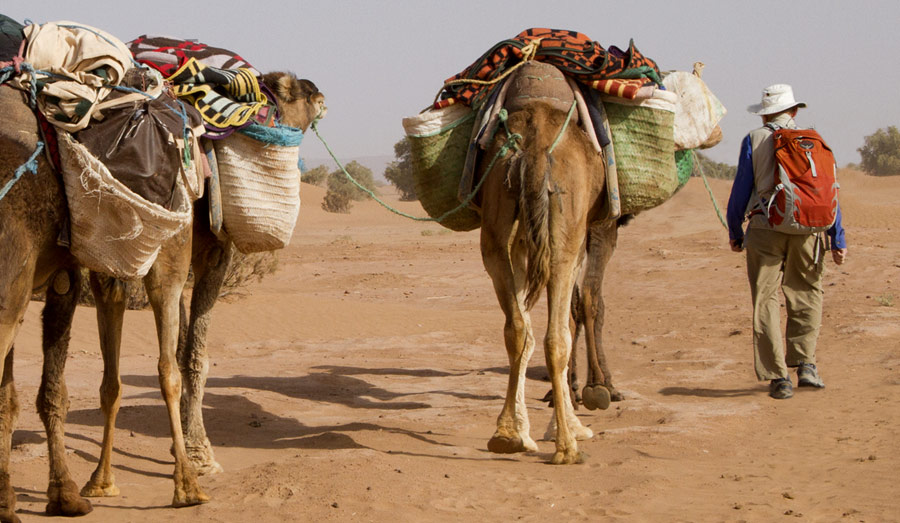
Contrary to popular misconception, camels do not store water in their humps. The humps are actually reservoirs for fatty tissue. Concentrating fat in their humps minimizes insulation throughout the rest of the body, thus allowing camels to survive in extremely hot regions. When this fatty tissue is metabolized, it acts as a source of energy, and yields more than 1 gallon of water for each 1 gallon of fat that is converted.
Ten More Camel Facts
1) Saharan camels (Dromedary) have one hump whereas Asian (Bactrian) camels native to the Gobi Desert, have two.
2) Camels have a double row of very long eyelashes and a clear inner eyelid that protects the eye from sandstorms while still letting in enough light for camels to see.
3) Camels’ ears are small and hairy to keep out sand and dust. However their sense of hearing is extremely strong.
4) Camels can drink 25 gallons of water in just a few minutes.
5) Baby camels (calves) are born without humps. They are however able to run within hours of birth. They call to their mothers with a lamb-like “baa” sound. Mother and child camel pairings are extremely close, staying together for several years. Tweet.
6) Camels have adapted to the hot, dry desert climate very nicely. Their thick coat reflects sunlight, which helps to keep them from overheating. The camel has long legs that keep their bodies farther away from the hot ground.
7) The camel is related to the alpaca, llama, guanaco and vicuna.
8) When camels walk they move both legs on one side of their body and then the other. Their feet are also flat and wide. Both of these features help them from sinking into the sand.
9) Camels have oval blood cells they do not clump together like ours do when they are dehydrated. This allows them to go longer periods of time without water.
10) Camels are herbivores meaning they eat mostly greens and vegetation. They eat grass, grains, seeds, twigs and even plants with thorns. Camels have thick lips that allow them to eat the thorny plants without getting hurt.
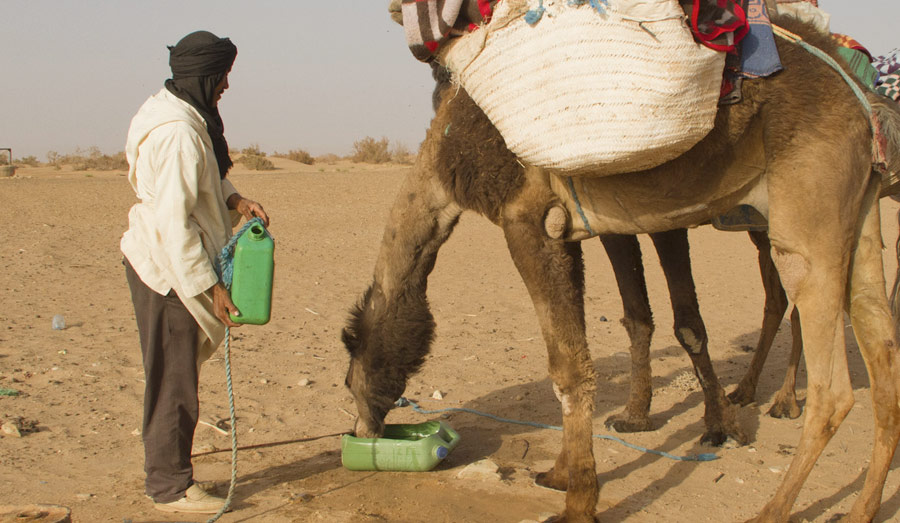
Traveling With Camels
A fully mature, healthy camel, walking at a speed of three miles per hour, can carry as much as 600 pounds for long distances. If the journey is longer than two weeks the load weighs about 400 pounds. Early on in the expedition planning process, we make inquiries concerning the best camel breeders in the area. Our goal is to find big, strong, well-bred, mature male camels that are used for work and carrying loads. We never buy a camel before seeing it and checking its disposition. A rogue camel with a bad attitude can be dangerous. We normally prefer to buy our camels. Prices vary. We have paid from $800 to $1,500 for a camel. After we have completed our expedition we always arrange to give our camels to a trusted friend who retires them from work. We provide some financial compensation for food and veterinary care of the animals. On our long desert journeys camels are vital to our success. They become family members and it makes our parting at journeys end easier if we know that they will lead a happy and safe forever life. We arrange the loads so that each camel has a heavy day followed by a light day. This avoids the need for frequent rest days and maintains good health and even camel tempers. Although camels have a reputation as bad tempered and uncooperative animals, we have found that with good treatment and care they carry our equipment day after day without complaint.
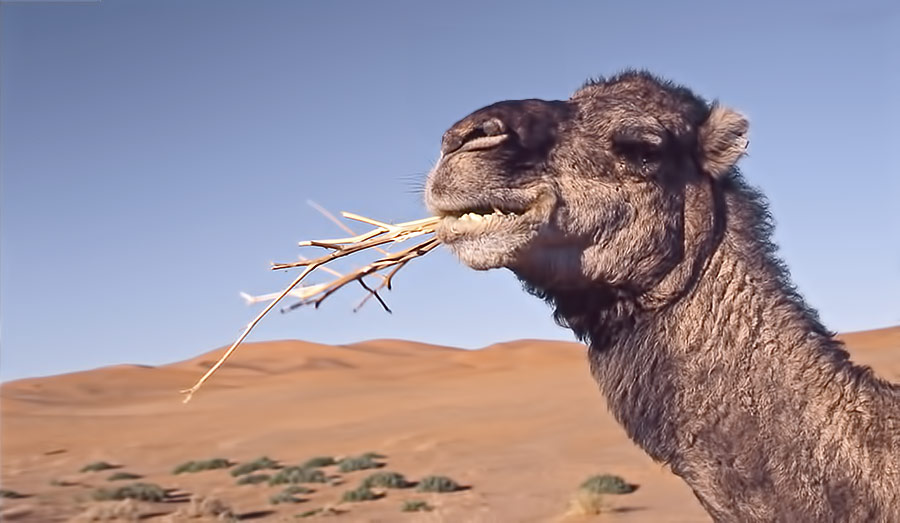
We use the loading equipment, such as loading yoke, ropes and baskets, that are normally used in the region we are traveling so that the camels are familiar with each piece of equipment. After the camel kneels, we check to make sure that there are no stickers or anything caught in the camel's coat that could cause discomfort. A thick blanket is spread across the camel's back and then the yoke is placed on top. This is shaped in a semi-circle and provides the foundation for the upcoming load. Large baskets are slung on each side of the camel and tied down. We take our time to ensure that the load is even on both sides and is comfortable. After loading is completed the camels are lined up one behind the other. Each one's lead rope is tied to the camel in front. When two or more camels are used there is always one camel that likes to lead. That camel normally leads for the entire journey. Camels are superbly adapted to obtaining adequate nutrition from desert shrubs and herbs that they consume when available. Their lips are thick and the upper lip is divided and very sensitive. It is well suited to pick small leaves from branches. Camels can devour even thorny dry branches without discomfort.
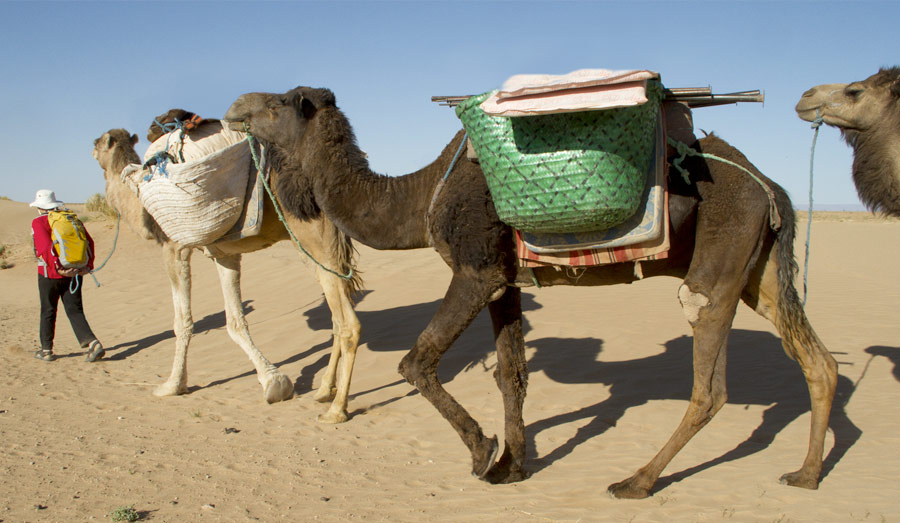
Each morning we feed grain, usually wheat or oats. We lay a feeding blanket on the ground and kneel the camels around the edge so that they can reach the grain we place on the blanket. We soon discovered that kneeling camels don't squabble over their food from the sitting position. If a camel is overly domineering we feed him alone to the side. Excessive grain feeding can also cause severe digestive problems. Camels are not used to a rich diet therefore we feed no more than two pounds of grain per day per camel. When a water source is a few days away we either don't feed grain or cut down to no more than half ration. Camels need water to help them digest grain. Camels love dates. We toss a few handfuls in with the grain as a tasty nutritious treat. Due to a camel's high requirement for salt, we sprinkle loose salt over the grain at feeding time. If we encounter an area of lush green grass we severely limit the camel's access to it as it can cause bloat. We carry a few sacks of hay when we know there will be stretches of desert that are so sterile that almost nothing grows there. Under controlled non-expedition conditions a camel can consume about eight pounds of hay a day, but under travel conditions the hay is used as a supplement when local forage is scarce. At any sign of lameness we immediately stop and examine the foot for any sharp object that might have penetrated the sole. In our camel first aid kit we include tincture of iodine, antibiotic ointment and stretch bandages in case a foot requires protection while it heals.
Back to [Home Page]
